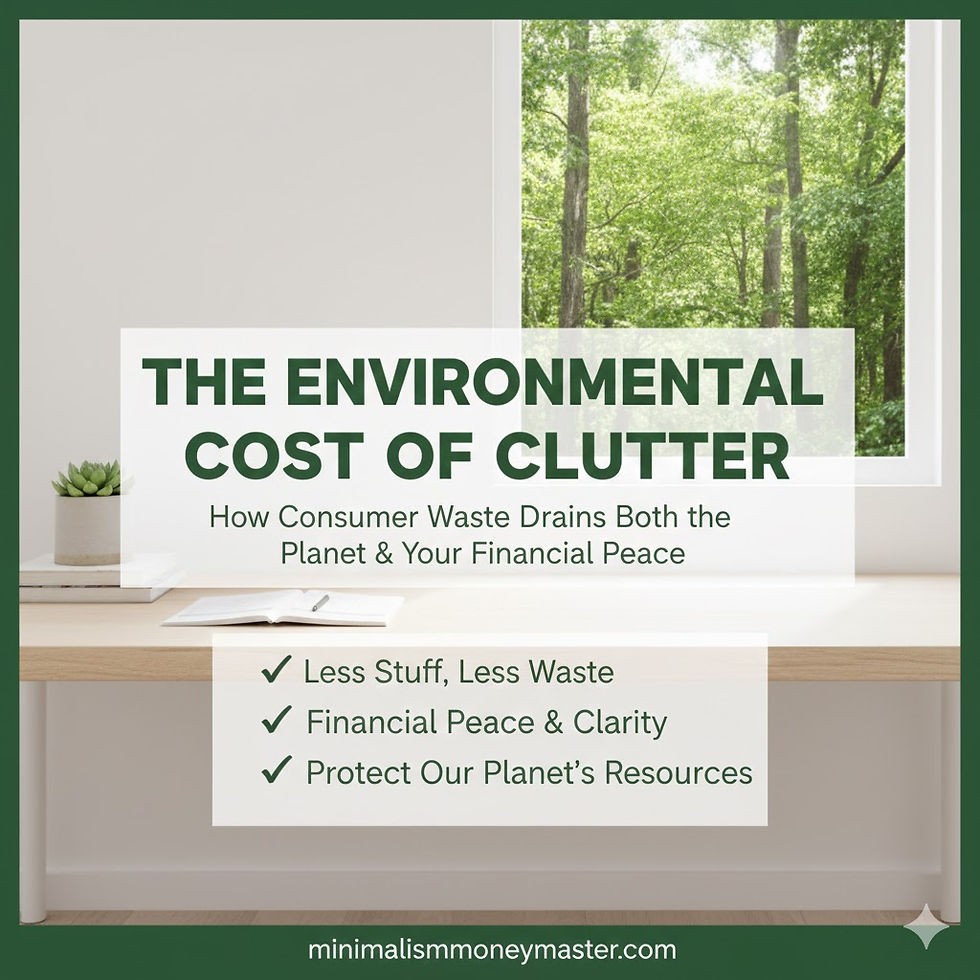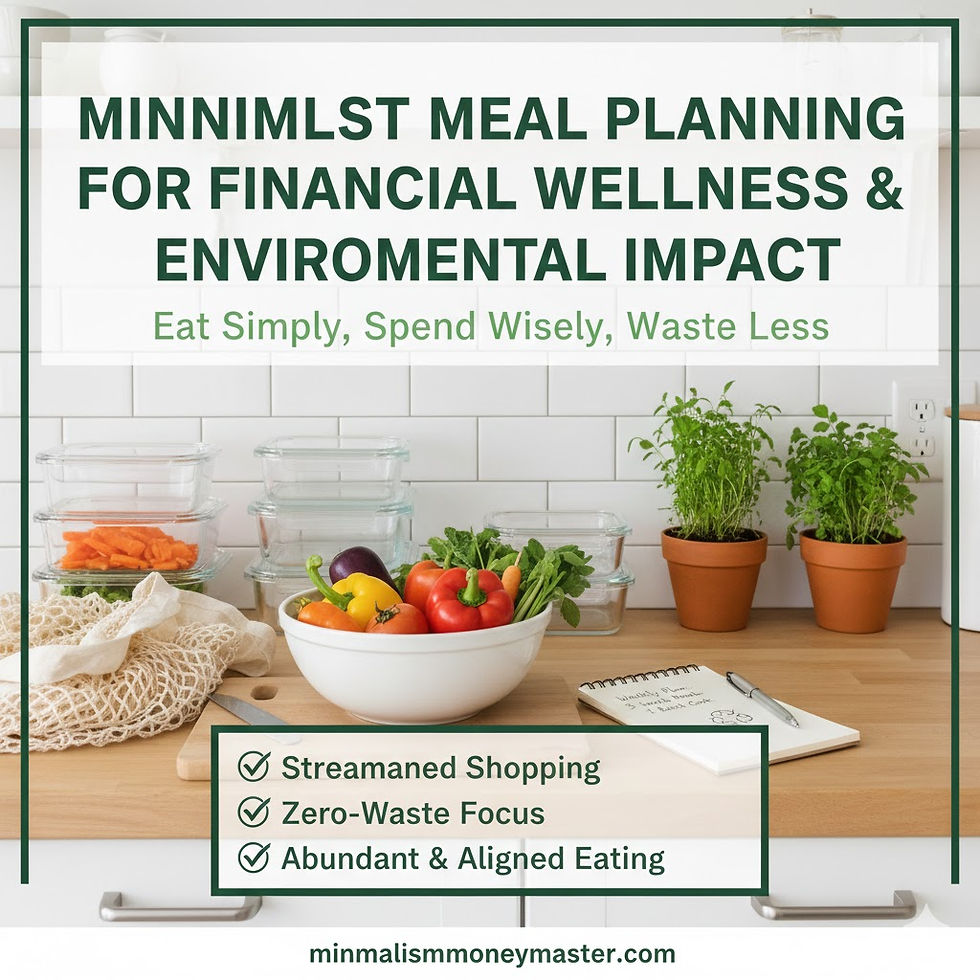How to Stop Living Paycheck to Paycheck with Minimalist Finance
- jennifercorkum
- Aug 27
- 3 min read
Learn how minimalist finance can help you stop living paycheck to paycheck. Discover simple, intentional strategies to simplify your money, save more, and create financial freedom.
How to Stop Living Paycheck to Paycheck: A Minimalist Finance Approach 🌿
If you’ve ever found yourself anxiously waiting for your next paycheck to cover bills, you’re not alone. Millions of people live paycheck to paycheck, struggling to build savings and feeling trapped in a cycle of financial stress.
But here’s the truth: it doesn’t have to be this way. By adopting a minimalist finance mindset, you can simplify your relationship with money, regain control over your finances, and create space for financial freedom.
Minimalist finance focuses on intentional spending, decluttering your financial systems, and aligning your money habits with your values. When you stop chasing “more” and focus on what truly matters, you can finally break free from the paycheck-to-paycheck lifestyle.
Here’s how to get started.
1. Get Clear on Your Numbers 📊
The first step in taking control of your finances is awareness. Many people feel stuck because they’re disconnected from where their money actually goes each month.
Action Steps:
List your monthly income after taxes.
Write down every fixed expense: rent/mortgage, utilities, insurance, etc.
Track variable expenses: dining out, shopping, streaming services, etc.
Use a simple tracking tool — one spreadsheet or app is all you need.
Minimalist finance thrives on simplicity. The goal isn’t to micromanage every penny but to create clarity so you know where your money flows and where you can make changes.
2. Prioritize Needs Over Wants 🌱
One of the biggest shifts in minimalist finance is understanding the difference between needs and wants.
Needs: Housing, groceries, healthcare, transportation, and basic clothing
Wants: Daily lattes, subscription boxes, impulse purchases, luxury upgrades
By focusing on essentials first, you make sure your basic needs are covered while cutting back on unnecessary spending. This doesn’t mean you never enjoy your wants — it simply means your spending becomes intentional instead of reactive.
Minimalist tip: Before making a purchase, pause and ask yourself:
“Does this add long-term value to my life?”
3. Create a Simple, Sustainable Budget 💡
Budgets often fail because they’re too complicated. Minimalist finance recommends a simple framework that’s easy to follow, like the 50/30/20 rule:
50% Needs: Housing, bills, food, and other essentials
30% Wants: Dining out, entertainment, hobbies
20% Savings & Debt Repayment: Emergency funds, retirement, and extra loan payments
This balanced approach ensures your needs are met, your wants are enjoyed guilt-free, and your savings consistently grow.
4. Build an Emergency Fund 🏦
One of the main reasons people stay stuck living paycheck to paycheck is a lack of financial cushion. Even a small unexpected expense — like a car repair — can spiral into debt.
Start Small, Think Big:
Aim for $500 to $1,000 as your first savings milestone
Automate transfers to a high-yield savings account
Use savings challenges, like the 100/100/90 Challenge, to build momentum
An emergency fund doesn’t just protect you financially — it also brings peace of mind.
5. Simplify and Automate Your Finances ⚡
Financial chaos often leads to financial stress. The fewer moving parts, the easier it is to stay in control.
Minimalist Steps to Simplify:
Use one checking and one savings account
Stick to one debit card and one credit card
Set up automatic payments for bills and savings
Cancel unused subscriptions and apps
By decluttering your financial life, you remove decision fatigue and create space for growth.
6. Focus on Intentional Spending 🛍️
Breaking free from the paycheck-to-paycheck cycle isn’t just about spending less — it’s about spending smarter.
Invest in quality items that last longer
Say “yes” to experiences that align with your values
Say “no” to lifestyle trends that don’t serve your goals
Minimalist finance is about designing a life where every dollar works for you instead of against you.
Final Thoughts: Freedom Through Simplicity 🌿
Living paycheck to paycheck can feel like an endless cycle, but adopting a minimalist finance mindset offers a way out. By simplifying your financial systems, prioritizing needs, and aligning your spending with your values, you create room for clarity, confidence, and peace.
Start small: track your expenses, automate your savings, and commit to intentional spending. Over time, these habits compound, leading to more stability, less stress, and the financial freedom you’ve been craving.
Remember, minimalism isn’t about having less — it’s about making room for more of what truly matters.







Comments